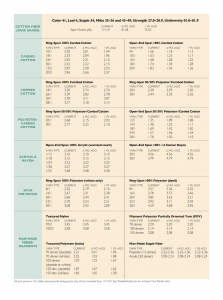 By Jim Phillips, Yarn Market Editor
By Jim Phillips, Yarn Market Editor
Cotton prices have soared in recent months to the highest levels in a decade.
For the week ended November 11, spot market cotton quotations for the base quality of cotton (color 41, leaf 4, staple 34, mike 35-36 and 43-49, strength 27.0-28.9, and uniformity 81.0-81.9) in the seven designated markets measured by the USDA averaged 114.19 cents per pound. This compares to 65.10 cents per pound for the corresponding period a year ago. The ICE December settlement price ended the week at 118.54 cents
The last time cotton prices were over a dollar per pound was in late September 2011. The highest yarn prices of the millennium were recorded during the first week of April 2011, when the price per pound reached $2.03 per pound. Those high prices were fueled by fears that a smaller-than-usual global cotton yield would prohibit spinners from fulfilling all orders. Before the 2010-2011 surge, the last time cotton prices topped $1.00 per pound was in mid-June 1995. The lowest price of the century was in early December 2001, when cotton fell to 37 cents per pound.
The recent surge in prices is a result of multiple issues. Droughts and heat have seriously impacted cotton yields in the United States. Consumer demand is high, with U.S. yarn spinners operating at or near capacity. Demand for U.S. cotton has dramatically increased in China. Trade restrictions put in place by the Trump administration because of forced labor in certain Chinese provinces prevent U.S. companies from importing goods made with cotton these areas. This has required many Chinese companies to buy U.S.-grown cotton to make goods that can then be sold back to consumers in the United States.
The increases in cotton prices, combined with global supply-chain issues, high energy prices, and labor shortages, have created the perfect storm of sorts, according to multiple experts. Customers want product and are willing to pay a premium, and spinners and fabricators are producing everything they can get their hands on. The problem is securing the materials to make their goods and then finding a way to navigate them through the global supply-chain maelstrom to get those products to customers.
“I have never seen anything like this,” said one industry executive. “It is normal to have to put out fires here and there, but right now there seems to be something burning in every facet of the business. It is frustrating when you have a hungry market and can’t quite find a way to feed it. We are running full schedules and producing everything we can. But regardless of how fast we work, we are still having issues getting product into the hands of our customers.”
Although few will address the issue head-on, there is some concern that a follow-up to high prices will be a precipitous drop should crop yields increase and demand decrease. “There is the lingering worry — what if the bottom falls out of the market again, like what happened in the early 2010s,” said an industry analyst. “At this point, December 2022 futures are running higher than December futures this time last year. So, for now, the anticipation is a continuation in strong demand, an increase in cotton yields, and relative stability in pricing. But there are not any guarantees. When cotton prices dropped so quickly in 2011 and 2012, a number of spinners were stuck with an inventory of $2.00 cotton that had a market value of maybe half of that. Is that likely to happen again? I would think it would be unlikely, but, just like the onset of COVID, which brought the global economy to a temporary halt, you never know what is on the horizon.”
Strong Growth Projected For Synthetic Fibers
Outside of cotton, the market for other fibers is expected to show robust growth over the next few years. According to a new study by Polaris Market Research, the global synthetic fibers market size is expected to reach $88.31 billion by 2028. CAGR is anticipated to be 6.5 percent per year from 2021 to 2028. “A rise in demand for lightweight, safe, and high-strength materials in the automobile, aerospace, and textile industries is driving the significant market growth,” the report states. “A growing preference for low carbon-emitting and low fuel consuming vehicles is anticipated to make a positive influence on the market. Breakthroughs in the research and development of green synthetic fibers and green bio fibers are further propelling the global market growth.”
November 2021





